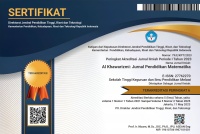MENINGKATKAN HASIL BELAJAR MATEMATIKA SISWA KELAS IV PADA MATERI BILANGAN CACAH MELALUI PENERAPAN MODEL PEMBELAJARAN NHT UPTD SDN 8 BARRU
DOI:
https://doi.org/10.46368/kjpm.v5i1.3394Abstract
Abstrak: Jurnal ini mengulas tentang materi Bilangan Cacah melalui model kooperatif tipe Numbered Head Togther dalam pembelajaran Matematika di SDN 8 Barru. Penelitian ini bertujuan untuk mengetahui pentingkatan hasil belajar siswa pada mata Pelajaran matematika pada materi bilangan cacah dikelas IV UPTD SDN 8 Barru, melalui penerapan model pembelajaran kooperatif tipe Numbered Head Together. Jenis penelitian ini adalah penelitian tindakan kelas (PTK). Adapun instrumen penelitiannya yaitu tes hasil belajar dan lembar kerja peserta didik (LKPD) . Sumber data penelitian adalah hasil pengamatan dikelas, wawancara dari guru matematika, dan peserta didik. Hasil penelitian menunjukkan bahwa peningkatan memahami materi bilangan cacah dengan menggunakan model Kooperatif Tipe Numbered Head Together mendapatkan hasil yang baik dan cukup memuaskan. Pada siklus I menunjukkan presentase peserta didik mencapai 33,34% dan presentase peserta didik pada siklus II mencapai 83,33%. Secara keseluruhan hasil belajar peserta didik materi bilangan cacah mengalami peningkatan pada setiap pertemuan.
Â
Kata Kunci: Bilangan Cacah, Hasil Belajar, Numbered Head Together
Â
Abstract : This journal reviews whole number material through the Numbered Head Togther type cooperative model in Mathematics learning at SDN 8 Barru. This research aims to determine the importance of student learning outcomes in mathematics subjects in whole number material in class IV SDN 8 Barru, through the application of the Numbered Head Together type cooperative learning model. This type of research is classroom action research (PTK). The research instruments are student worksheets (LKPD) and the research data sources are the results of classroom observations, interviews with mathematics teachers and students. The results of the research show that improving understanding of whole number material by using the Numbered Head Together Cooperative model produces good and quite satisfactory results. In cycle I, the percentage of students reached 33.34% and the percentage of students in cycle II reached 83.33%. Overall, the learning outcomes of students on whole number material have increased at each meeting.
Â
Keywords: Whole Numbers, Learning Outcomes, Numbered Heads TogetherReferences
Ananda, R. A., Inas, M., & Setyawan, A. (2022). Pentingnya Pendidikan Karakter pada anak Sekolah Dasar di Era Digital. Jurnal Pendidikan, Bahasa Dan Budaya, 1(4), 83-88.
Asih, N. N. D., Arifin, I. N., & Marshanawiah, A. (2024). Meningkatkan Hasil Belajar Matematika Siswa melalui Model Kooperatif Tipe STAD berbantuan Media Takalintar pada Materi Operasi Perkalian Bilangan Cacah Kelas IV SDN 14 Bongomeme. Pendas: Jurnal Ilmiah Pendidikan Dasar, 9(2), 7286-7293.
Hapnita, W. (2018). Faktor internal dan eksternal yang dominan mempengaruhi hasil belajar menggambar dengan perangkat lunak siswa kelas XI teknik gambar bangunan SMK N 1 Padang tahun 2016/2017. Cived, 5(1).
Kurnia, V. T., & Damayani, A. T. (2019). Keefektifan Model Pembelajaran Number Head Together (NHT) Berbantu Media Puzzle terhadap Hasil Belajar Matematika. Jurnal Ilmiah Sekolah Dasar, 3(2), 192–201. https://doi.org/10.23887/jisd.v3i2.17772.
Munandar, S. A., Fitriani, A., Karlina, Y., Yumriani, Y., & BP, A. R. (2022). Pengertian Pendidikan ilmu pendidikan dan unsur-unsur pendidikan. Al Urwatul Wutsqa, 2(1), 1-8
Downloads
How to Cite
Issue
Section
Citation Check
License
Authors who publish with this journal agree to the following terms:
1. Authors retain copyright and grant the journal right of first publication with the work simultaneously licensed under a Creative Commons Attribution License that allows others to share the work with an acknowledgement of the work's authorship and initial publication in this journal.
2. Authors are able to enter into separate, additional contractual arrangements for the non-exclusive distribution of the journal's published version of the work (e.g., post it to an institutional repository or publish it in a book), with an acknowledgement of its initial publication in this journal.
3. Authors are permitted and encouraged to post their work online (e.g., in institutional repositories or on their website) prior to and during the submission process, as it can lead to productive exchanges, as well as earlier and greater citation of published work.






